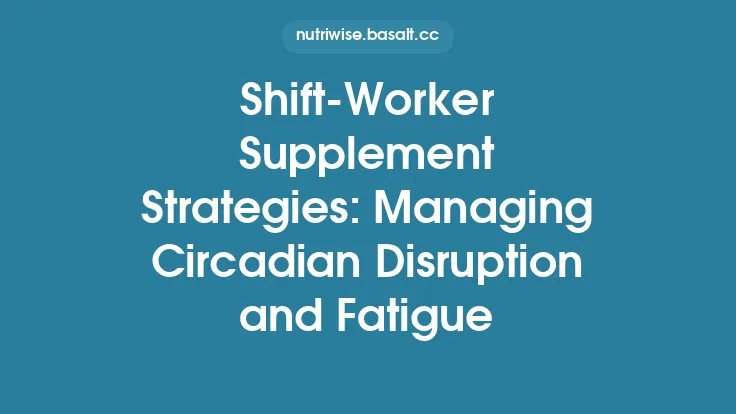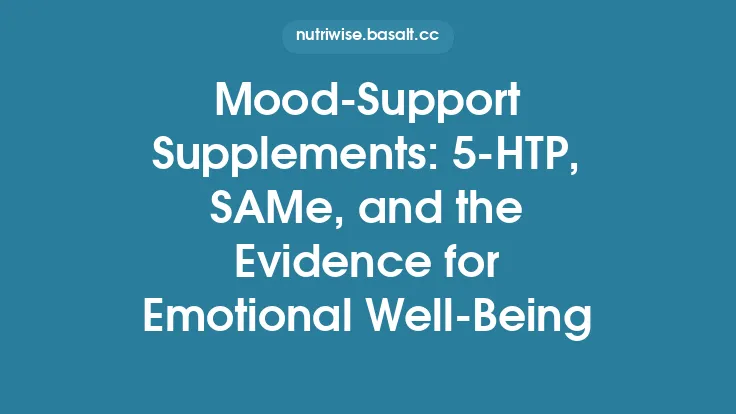Sleep is a cornerstone of overall health, yet modern life often conspires against a restorative night’s rest. While lifestyle adjustments—such as consistent bedtime routines, limiting screen exposure, and optimizing the sleep environment—are foundational, many individuals turn to targeted supplements to bridge the gap between intention and reality. Among the most researched and widely used sleep‑aid supplements are melatonin and magnesium, each operating through distinct physiological pathways. Complementary natural agents, ranging from herbal extracts to amino acids, can further enhance sleep quality when integrated thoughtfully. This article delves into the science behind these nutrients, outlines evidence‑based dosing strategies, highlights safety considerations, and offers practical guidance for incorporating them into a holistic sleep‑support plan.
Understanding the Physiology of Sleep
A brief refresher on sleep architecture helps clarify why certain supplements are effective. Sleep is organized into cycles of rapid eye movement (REM) and non‑REM (NREM) stages. NREM itself is subdivided into three stages (N1, N2, N3), with N3 representing deep, slow‑wave sleep crucial for physical restoration, hormone regulation, and memory consolidation. REM sleep, on the other hand, supports emotional processing and cognitive function.
Two primary neurochemical systems govern the transition between wakefulness and sleep:
- The Circadian Clock – Located in the suprachiasmatic nucleus (SCN) of the hypothalamus, this internal timekeeper synchronizes physiological processes to the 24‑hour light‑dark cycle. Light exposure suppresses melatonin secretion, while darkness triggers its release, signaling the body that it is time to wind down.
- The Homeostatic Sleep Drive – Often described as “sleep pressure,” this builds up during waking hours through the accumulation of adenosine and other metabolites. The longer one stays awake, the stronger the drive for sleep becomes.
Effective sleep‑aid supplementation typically targets one or both of these systems, either by augmenting the natural melatonin signal or by modulating neurotransmitters that influence the homeostatic drive.
Melatonin: The Hormone of Darkness
What Is Melatonin?
Melatonin (N‑acetyl‑5‑methoxytryptamine) is a pineal‑derived indoleamine produced in response to darkness. Its secretion follows a characteristic pattern: low during daylight, rising shortly after sunset, peaking in the middle of the night, and tapering before sunrise. Beyond its role as a chronobiotic (a time‑shifting agent), melatonin possesses antioxidant, immunomodulatory, and anti‑inflammatory properties.
Mechanisms Relevant to Sleep
- Circadian Phase Shifting – Exogenous melatonin can advance or delay the circadian rhythm depending on timing of administration. When taken 2–4 hours before the desired bedtime, it signals the SCN that night is approaching, facilitating earlier sleep onset.
- Sleep Initiation – By binding to MT1 and MT2 receptors in the SCN and other brain regions, melatonin reduces neuronal firing rates, promoting the transition from wakefulness to sleep.
- Sleep Architecture – Research indicates modest increases in total sleep time (TST) and sleep efficiency, particularly in populations with delayed sleep phase syndrome, shift‑work schedules, or age‑related melatonin decline.
Evidence Overview
- Meta‑analyses of randomized controlled trials (RCTs) consistently show that low‑dose melatonin (0.3–5 mg) reduces sleep latency by 5–15 minutes in adults with primary insomnia or jet lag.
- Older adults often experience a blunted endogenous melatonin rhythm; supplementation (0.5–2 mg) can restore more youthful patterns and improve sleep continuity.
- Children with neurodevelopmental disorders (e.g., autism spectrum disorder) have demonstrated improved sleep onset and reduced night awakenings with doses ranging from 0.5–3 mg, though pediatric use should be supervised.
Dosing Strategies
| Goal | Typical Dose | Timing | Comments |
|---|---|---|---|
| General sleep onset support | 0.5–3 mg | 30–60 min before bedtime | Start low; increase only if needed |
| Shift‑work or jet lag | 0.5–5 mg | 1–2 h before desired sleep time | Adjust based on direction of travel or shift |
| Age‑related decline | 0.3–2 mg | 30 min before bedtime | Lower doses mimic physiological levels |
| Pediatric use (under specialist guidance) | 0.5–3 mg | 30 min before bedtime | Weight‑based adjustments may be required |
Safety Profile
Melatonin is generally well tolerated. Reported side effects are mild and include:
- Drowsiness the next morning (often mitigated by lower dosing)
- Vivid dreams or mild nightmares
- Headache
- Gastrointestinal discomfort
Because melatonin can interact with anticoagulants, immunosuppressants, and certain antihypertensives, individuals on these medications should consult a healthcare professional before initiating supplementation.
Magnesium: The Mineral of Relaxation
Why Magnesium Matters for Sleep
Magnesium (Mg²⁺) is the fourth most abundant cation in the human body and a cofactor in over 300 enzymatic reactions. Its relevance to sleep stems from several mechanisms:
- GABAergic Modulation – Magnesium acts as a natural calcium antagonist at NMDA receptors and enhances the activity of γ‑aminobutyric acid (GABA), the primary inhibitory neurotransmitter that promotes calmness and sleep.
- Regulation of the HPA Axis – Adequate magnesium helps blunt the hypothalamic‑pituitary‑adrenal (HPA) stress response, reducing cortisol spikes that can fragment sleep.
- Muscle Relaxation – By influencing calcium influx in muscle cells, magnesium facilitates smooth muscle relaxation, potentially reducing nighttime leg cramps and restless leg syndrome (RLS) symptoms.
- Circadian Rhythm Support – Emerging data suggest magnesium may influence the expression of clock genes, subtly aligning peripheral clocks with the central SCN.
Forms of Magnesium and Bioavailability
Not all magnesium supplements are created equal. Bioavailability varies by salt form:
| Form | Approx. Bioavailability* | Typical Uses |
|---|---|---|
| Magnesium glycinate (chelated) | High (≈ 80‑90 %) | Sleep, anxiety, muscle relaxation |
| Magnesium citrate | Moderate‑high (≈ 70‑80 %) | Constipation, general supplementation |
| Magnesium threonate | Moderate (≈ 50‑60 %) | Cognitive support (crosses blood‑brain barrier) |
| Magnesium oxide | Low (≈ 4‑10 %) | Laxative effect; not ideal for sleep |
| Magnesium chloride | High (≈ 80‑90 %) | Topical preparations (magnesium oil) |
\*Values are approximate and can differ based on individual absorption efficiency.
Evidence Overview
- RCTs using magnesium glycinate or citrate (200–400 mg elemental magnesium) have demonstrated reductions in sleep latency (≈ 7–10 minutes) and increases in sleep efficiency (≈ 5‑10 %) in older adults with insomnia.
- Meta‑analysis of 7 trials (total n ≈ 400) reported a pooled effect size of 0.45 for improved sleep quality (measured by the Pittsburgh Sleep Quality Index) with magnesium supplementation.
- Combination therapies (e.g., melatonin + magnesium) often yield additive benefits, suggesting complementary mechanisms.
Dosing Recommendations
| Population | Elemental Mg Dose | Preferred Form | Timing |
|---|---|---|---|
| Adults (general) | 200–300 mg | Glycinate or citrate | 30 min before bedtime |
| Older adults | 300–400 mg | Glycinate (to minimize GI upset) | 30 min before bedtime |
| Individuals with RLS or muscle cramps | 300–400 mg | Glycinate or threonate | Evening dose |
| Athletes or high‑stress individuals | 400–500 mg (split) | Citrate (split morning/evening) | Evening dose for sleep |
Note: The Recommended Dietary Allowance (RDA) for magnesium is 310–420 mg/day (depending on age and sex). Supplementation should consider total dietary intake to avoid excess, which can cause diarrhea or, rarely, hypermagnesemia in renal impairment.
Safety and Interactions
- Common side effects: Loose stools, abdominal cramping (more common with poorly absorbed forms like oxide).
- Drug interactions: May potentiate the effects of certain blood pressure medications, bisphosphonates, and antibiotics (e.g., tetracyclines, fluoroquinolones) by chelating them and reducing absorption. Space supplementation at least 2 hours apart from these drugs.
- Renal considerations: Individuals with chronic kidney disease should avoid high‑dose magnesium without medical supervision.
Other Natural Sleep‑Aid Supplements
While melatonin and magnesium are the workhorses of sleep support, several additional botanicals and amino acids have garnered scientific interest. Their efficacy varies, and many work best as part of a broader sleep hygiene regimen.
1. L‑Theanine
- Source: Amino acid abundant in green tea (Camellia sinensis).
- Mechanism: Promotes alpha‑wave activity, reduces excitatory neurotransmission, and may increase GABA, dopamine, and serotonin levels without sedation.
- Evidence: 200 mg of L‑theanine taken 30 minutes before bedtime has been shown to improve sleep quality scores and reduce sleep latency in mildly anxious adults.
- Safety: Generally well tolerated; rare reports of headache or gastrointestinal discomfort.
2. Valerian Root (Valeriana officinalis)
- Active constituents: Valerenic acids, iridoids.
- Mechanism: Modulates GABA‑A receptors, possibly inhibiting reuptake and enhancing inhibitory signaling.
- Evidence: Meta‑analyses suggest modest improvements in sleep latency and quality, especially at doses of 400–900 mg of standardized extract taken 30 minutes to 2 hours before sleep.
- Safety: May cause vivid dreams or morning grogginess; avoid combining with other sedatives.
3. Passionflower (Passiflora incarnata)
- Mechanism: Flavonoids (e.g., chrysin) interact with GABA‑A receptors.
- Evidence: Small RCTs indicate reduced sleep onset latency and improved sleep efficiency at 250–500 mg of extract.
- Safety: Generally safe; caution in individuals on anticoagulants.
4. Glycine
- Mechanism: An inhibitory neurotransmitter that lowers core body temperature when taken before sleep, facilitating the onset of NREM sleep.
- Evidence: 3 g of glycine 30 minutes before bedtime lowered sleep latency by ~30 minutes and improved subjective sleep quality in a crossover study.
- Safety: Minimal side effects; high doses may cause mild nausea.
5. Tart Cherry Juice (Montmorency)
- Active component: Natural melatonin and polyphenols.
- Evidence: Consuming 240 ml of tart cherry juice twice daily for two weeks increased melatonin levels and modestly improved sleep duration in older adults.
- Safety: Sugar content may be a concern; opt for concentrate or low‑sugar formulations.
6. Adaptogenic Herbs (e.g., Ashwagandha, Rhodiola)
- Mechanism: Modulate the HPA axis, reducing cortisol and promoting a relaxed state conducive to sleep.
- Evidence: Standardized ashwagandha root extract (300 mg of high‑withanolide content) taken nightly improved sleep efficiency and reduced nighttime awakenings in a 12‑week trial.
- Safety: Generally safe; high doses may cause gastrointestinal upset.
Integrating Supplements with Sleep Hygiene Practices
Supplements are most effective when paired with evidence‑based behavioral strategies. Below is a step‑by‑step framework for building a comprehensive sleep‑support plan.
- Establish a Consistent Sleep‑Wake Schedule
- Go to bed and rise at the same time daily, even on weekends. Consistency reinforces the circadian clock, making supplemental cues (e.g., melatonin) more potent.
- Optimize Light Exposure
- Morning: Seek bright natural light within the first hour of waking to anchor the circadian rhythm.
- Evening: Dim lights 2–3 hours before bedtime; use amber or red bulbs to minimize blue‑light suppression of melatonin.
- Create a Sleep‑Friendly Environment
- Keep the bedroom cool (≈ 18–20 °C), quiet, and dark. Blackout curtains, white‑noise machines, and comfortable bedding all contribute to uninterrupted sleep.
- Limit Stimulants and Alcohol
- Avoid caffeine after 2 p.m. and limit alcohol to ≤ 1 standard drink in the evening, as both can fragment sleep architecture.
- Incorporate Relaxation Techniques
- Practices such as progressive muscle relaxation, deep‑breathing, or mindfulness meditation can lower sympathetic tone, priming the body for supplement efficacy.
- Timing of Supplement Intake
- Melatonin: 30–60 minutes before desired sleep time.
- Magnesium: 30 minutes before bed, preferably with a small snack to improve absorption.
- L‑theanine or Glycine: 30 minutes prior.
- Herbal extracts (valerian, passionflower): 30 minutes to 2 hours before bedtime, depending on formulation.
- Monitor and Adjust
- Keep a simple sleep diary (bedtime, wake time, perceived sleep quality, supplement dose). After 2–3 weeks, assess trends and adjust dosage or timing as needed.
Safety, Dosage, and Potential Interactions
| Supplement | Typical Effective Dose Range | Common Side Effects | Notable Interactions |
|---|---|---|---|
| Melatonin | 0.3–5 mg (occasionally up to 10 mg) | Drowsiness, vivid dreams, headache | Anticoagulants, immunosuppressants, antihypertensives |
| Magnesium (glycinate/citrate) | 200–400 mg elemental Mg | Diarrhea, abdominal cramping | Bisphosphonates, tetracyclines, fluoroquinolones |
| L‑Theanine | 100–400 mg | Rare headache, GI upset | None significant |
| Valerian | 400–900 mg extract | Morning grogginess, vivid dreams | Sedatives, alcohol |
| Passionflower | 250–500 mg extract | Mild dizziness | Sedatives, anticoagulants |
| Glycine | 3 g | Nausea (high doses) | None significant |
| Ashwagandha (high‑withanolide) | 300 mg | GI upset, drowsiness | Thyroid medications, immunosuppressants |
General Precautions
- Pregnancy & Lactation: Most sleep‑aid supplements lack robust safety data for pregnant or nursing individuals. Consultation with a healthcare provider is essential.
- Chronic Conditions: Those with depression, bipolar disorder, or severe anxiety should discuss supplement use, as melatonin can influence mood regulation.
- Medication Review: Always review current prescriptions with a pharmacist or physician before adding any supplement, especially if you take CNS depressants, antihypertensives, or anticoagulants.
Choosing Quality Products and Reading Labels
The supplement market is largely unregulated, making product selection critical for safety and efficacy.
- Third‑Party Certification – Look for seals from NSF International, USP, Informed‑Sport, or ConsumerLab. These indicate testing for purity, potency, and absence of contaminants.
- Transparent Labeling – The label should list:
- Exact amount of active ingredient (e.g., “melatonin 1 mg” rather than “melatonin complex”).
- Form of the ingredient (e.g., “magnesium glycinate”).
- Full list of excipients (fillers, binders, flavorings) to identify potential allergens.
- Shelf Stability – Melatonin is sensitive to light and heat; choose opaque, airtight containers. Magnesium supplements should be stored in a dry place to prevent clumping.
- Avoid Proprietary Blends – Unless the blend’s composition is disclosed, you cannot verify dosage or safety.
- Check Expiration Dates – Potency can decline over time, especially for botanical extracts.
When to Seek Professional Guidance
While many individuals achieve better sleep with over‑the‑counter supplements, certain scenarios warrant a deeper clinical evaluation:
- Persistent Insomnia (> 3 months) – May indicate underlying sleep disorders (e.g., sleep apnea, restless leg syndrome) that require diagnostic testing.
- Concurrent Psychiatric Conditions – Depression, anxiety, or bipolar disorder can both cause and be exacerbated by sleep disturbances; a mental health professional can tailor treatment.
- Complex Medication Regimens – Polypharmacy increases the risk of interactions; a physician or pharmacist can perform a comprehensive review.
- Renal or Hepatic Impairment – Impaired clearance of magnesium or melatonin may necessitate dose adjustments or alternative strategies.
- Pregnancy, Lactation, or Pediatric Use – Specialized dosing and safety considerations apply.
Putting It All Together: A Sample Nighttime Routine
Below is a practical illustration of how the discussed elements can be combined into a cohesive nightly protocol. Adjustments should reflect personal tolerance, health status, and lifestyle.
| Time | Activity | Supplement (if any) |
|---|---|---|
| 7:00 p.m. | Light dinner (balanced macronutrients, low caffeine) | — |
| 8:30 p.m. | Dim lights, switch to amber bulbs; turn off electronic devices or use blue‑light filters | — |
| 9:00 p.m. | 10‑minute mindfulness meditation + gentle stretching | — |
| 9:30 p.m. | Warm herbal tea (caffeine‑free) | Optional L‑theanine 200 mg (if anxiety is a factor) |
| 9:45 p.m. | Take magnesium glycinate 300 mg (elemental) with a small snack (e.g., banana) | — |
| 10:00 p.m. | Bedtime routine (brush teeth, set alarm) | Melatonin 1 mg (or 0.5 mg if sensitive) |
| 10:15 p.m. | Lights out; maintain cool, dark bedroom environment | — |
| 6:30 a.m. | Wake up, expose self to natural light | — |
Key Points of the Routine
- Sequential layering of relaxation techniques primes the nervous system before supplement intake.
- Low‑dose melatonin mimics physiological nighttime rise, reducing the risk of morning grogginess.
- Magnesium taken with a small carbohydrate source improves absorption and mitigates GI upset.
- Consistent timing reinforces circadian cues, making each subsequent night easier.
Bottom Line
Sleep‑aid supplements such as melatonin and magnesium offer scientifically grounded pathways to improve sleep onset, continuity, and overall quality. When selected thoughtfully—considering form, dose, timing, and individual health status—and paired with robust sleep hygiene practices, they can transform restless nights into restorative rest. As with any health intervention, personal experimentation should be guided by evidence, monitored for efficacy and safety, and complemented by professional advice when needed. By integrating these tools into a holistic lifestyle, individuals can reclaim the deep, uninterrupted sleep essential for optimal physical and mental performance.





